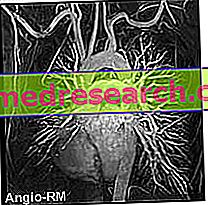See also: coronarography
What is Angiography?
Angiography is a radiological exam that allows the visualization of certain vascular districts, in order to study their morphology and course, and to reveal possible alterations.
Traditional angiography uses X-rays to obtain a diagnostic representation of blood and lymphatic vessels.

Depending on the injection site, angiography takes on particular names, such as ventriculography, aortography, coronary angiography, etc.
The injection of the contrast medium can be performed by direct puncture, or, when the examined district is not directly accessible (think of the coronaries of the heart), by catheterization. In the latter case, the catheter, an extremely thin and flexible tube, is penetrated into the arterial access point and pushed into the vessels until it reaches the vascular district to be examined. Thanks to local anesthesia, performed during the puncture, the examination is not painful, while the release of the contrast medium can produce a short and localized sensation of heat or tension.
In the absence of the contrast medium, the radiographic image would not provide any useful information on the state of health of the analyzed district. Together with the high radiopacity, which makes it possible to clearly distinguish the vessel in which it is injected, the contrast agent must have adequate water solubility and tolerability. It is eliminated by renal and urinary tract.
At the beginning of its development, angiography was performed on a special radiological plate, with a limited recovery rate that allowed only the morphology of the vessels to be assessed.
With the refinement of radiological techniques, new methods of recovery have been developed, such as the digitalized ones that allow to study the circulatory dynamics and appreciate the functionality of the vessels in a less invasive way. Thanks to the equipment's ability to highlight even poorly matted vessels, there is now the possibility of reducing the amount of contrast agent used, which can also be injected intravenously. Frames and videos are no longer saved on plates or films, but on CD-roms or other storage media.
The digital angiography techniques are based on the computerized radiological reconstruction of the vessel, after subtracting from the frames - properly amplified - the image obtained before the introduction of the contrast medium. In this way the static structures of the image are eliminated, such as bones and other organs (which appear with the same intensity before and after the introduction of the contrast agent), obtaining greater clarity of the blood vessels. This technique, called DSA ( Digital Subtraction Angiography ), cannot be applied to the study of the heart.
Interventional Angiography and Stent
Once the diagnostic part is complete, it is possible to intervene with appropriate endovascular treatments, aimed at resolving the identified pathological condition. One example is the application of stents to restore the patency of an occluded vessel (see angioplasty). In these cases there is talk of interventional angiography .
Angio-MRI and Angio-TC
The angiographic examination can also be conducted by exploiting the potential of magnetic resonance imaging (angio-MR) or computerized tomography (CT angiography).
In the first case non-ionizing radiation is used and the appropriate contrast medium, not always necessary and injected intravenously, has a lower degree of toxicity than that used in traditional X-ray angiography.
The advantages of CT angiography are in the lower proportion of radiation administered and in the less invasive procedure of injection of the contrast medium, which occurs intravenously rather than arterially.
Both techniques produce three-dimensional images and are part of the so-called "non-invasive" imaging methods that will characterize the near future of radiology.
We must not forget that angiography, be it traditional or digital, is not free of risks, including non-negligible mortality rates; for this reason the new imaging techniques have greatly reduced their use.



